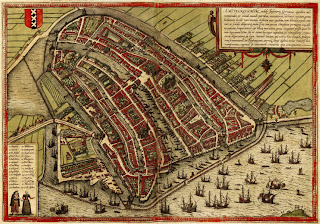 In 1640,
the immigrant brothers John and Richard Ogden from Bradley Plain, Hampshire,
England, arrived at the port of Southampton, Long Island. This particular John
Ogden (b. 1609) is referred to in history as John “the Pilgrim” Ogden to
differentiate him from his cousin, also named John Ogden, and pilgrim indeed he
was.
In 1640,
the immigrant brothers John and Richard Ogden from Bradley Plain, Hampshire,
England, arrived at the port of Southampton, Long Island. This particular John
Ogden (b. 1609) is referred to in history as John “the Pilgrim” Ogden to
differentiate him from his cousin, also named John Ogden, and pilgrim indeed he
was.
William
Ogden Wheeler, a descendant of John Ogden and author of the book The Ogden
Family in America, says this about John the Pilgrim: “It is true that a close
study of the ‘good old times’ reveals the presence and doings of many selfish
and unscrupulous men, and the Colonial period thus loses much of its pristine
fascination; yet the sturdy, self- poised, resolute, and godly Pilgrims and
Quakers, whose righteous principles and lives were interwoven in the American
fabric of civil and religious liberties, are to be held in the highest
veneration by their numerous descendants. To this class belonged John Ogden,
the Pilgrim . . . .”
John
Ogden and his son after him, David Ogden, were stone church builders. At the
time of Ogden’s arrival on this continent, New York was a Dutch colony called
New Amsterdam. Like many of the early Americans, the Dutch immigrants were
members of the Reformed religion, that is, they followed the teachings of John
Calvin (much like the Presbyterians of Scotland). One of their early needs,
therefore, was the construction of a church. To this end, they employed John
the Pilgrim to build a stone church in New Amsterdam. The image above right
depicts the church the Ogdens built, rising above other buildings in Fort Amsterdam, while the plan of New
Amsterdam (below right) shows the sizable area given over to the church and
churchyard in the southwest corner of the town.
Wheeler
provides these details about the church's construction: “A contract was drawn
up in May, 1642, setting forth an agreement between Governor William Kieft,
Gisbert op Dyck, and Thomas Willet, of New Amsterdam, Church-wardens, to build
a stone church in the fort, 72 ft. by 50 ft. and 16 ft. above the soil, for the
sum of 2500 guilders (about $1000), to be paid in cash, beaver or other
merchandise; if the work was done ‘in a workmanlike manner’ 100 extra guilders
were to be paid the contractors, John Ogden and his brother Richard, both of
Stamford, Conn. It was stipulated that the latter should be allowed the use of
the company's boat to ferry the stone ashore near the fort, the wardens
agreeing to carry the stone from the shore to the fort, and to furnish the lime
with which to lay them.”
 The old stone church of Fairfield
Township, New Jersey (left), which still stands, is of the type that David
Ogden built. Though the style was influenced by the Quaker churches of the era,
this was a Presbyterian church. Interestingly, the graves of numerous Ogdens
are in the churchyard.
The old stone church of Fairfield
Township, New Jersey (left), which still stands, is of the type that David
Ogden built. Though the style was influenced by the Quaker churches of the era,
this was a Presbyterian church. Interestingly, the graves of numerous Ogdens
are in the churchyard.
A resident of Newark, New Jersey,
David Ogden (b. 1639), son of John the Pilgrim, was also a stone church
builder. Wheeler notes that the Newark Town Records of 1670 state that “nearly
all the trades and callings necessary to the convenience and comfort of the
colony were represented”; among them is mentioned “a stone church builder,
David Ogden.”
Sources:
Free Amsterdam. http://www.freeamsterdam.nl/news/culture-and-history/amsterdam-history/oldnew-amsterdam.html
Fairfield Township, NJ. Web. http://www.fairfieldtownshipnj.org/default.asp?contentID=6
Wheeler,
William Ogden. The Ogden Family in America, Elizabethtown Branch, and Their
English Ancestry: John Ogden, the Pilgrim, and His Descendants, 1640-1906. http://www.ebooksread.com/authors-eng/william-ogden-wheeler/the-ogden-family-in-america-elizabethtown-branch-and-their-english-ancestry-j-eeh/page-2-the-ogden-family-in-america-elizabethtown-branch-and-their-english-ancestry-j-eeh.shtml
© Eileen
Cunningham, 2013
http://geneabloggers.com















